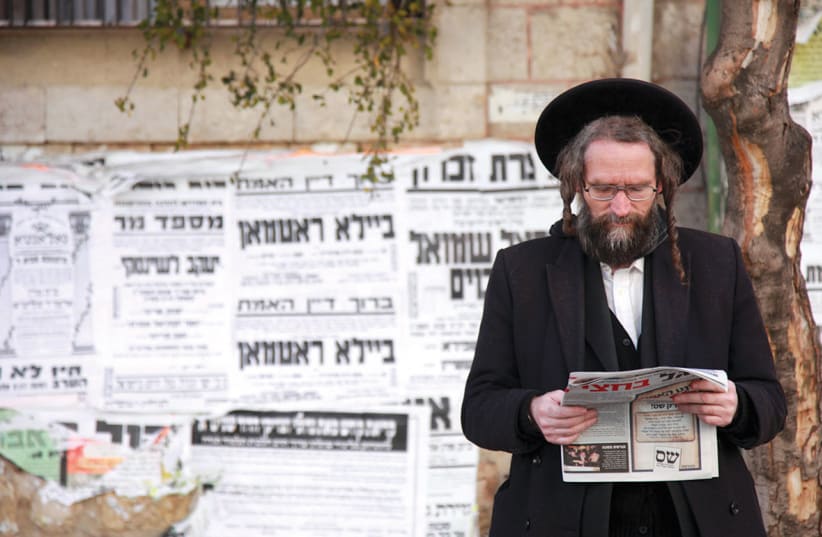Yoel Cohen’s new book, Rabbis, Reporters and the Public in the Digital Holyland, is intended for readers with a serious interest in the media and Judaism in Israel, their interrelationship, and the religious dimension in general within Israeli society. It appears as part of a new series of academic works by the publisher called “Routledge Studies in Middle East Film and Media.” It is, therefore, likely to be of special interest to students and researchers in the fields of study covered by the book.
Cohen is emeritus professor in the School of Communications at Ariel University. Among his other publications is God, Jews and the Media. This new work is based on the results of original research by Cohen, including a detailed analysis of the coverage of religion by four Israeli news websites.
In addition, he undertook a series of surveys of rabbis, journalists, and the public, and backed this by a multitude of interviews with a wide variety of people associated, in one way or another, with his field of interest. In an Appendix, he provides two pages of names which he terms a “selected list of persons interviewed.” An intriguing note at the end reads: “The names of Orthodox religious court judges are not listed, since it is forbidden for judges (including religious court judges – dayanim ) to give interviews.” He leaves the reader to work out the implications of this remark.
It is not, perhaps, surprising that an early discovery was the marked lack of understanding among many rabbis about the mass media, matched by comparative ignorance about religion in a fair number of journalists.
Examining the media, rabbis, and the general public
Cohen examines each group in depth. He finds that many rabbis perceive a distance, often an antagonism, between the media and Judaism, and he ascribes this to the negative image of religion and religious people often portrayed by the media. He acknowledges that many rabbis fear that their communities will be “morally polluted” by exposure to the media, and concludes that the gap between rabbis and the secular press is too great for hopes of productive dialogue. Consequently, he writes, haredi and to a lesser degree Orthodox-cum-Hardal rabbis have, as he puts it, “taken the path of escapism to create their own alternative frum [religious] media.”
He regrets this. “It deepens the secular-religious divide,” he writes. He thinks that rabbis are not generally aware of the degree of expertise brought by the media to the reporting of religious matters, nor the extent to which the journalistic principles of objectivity are applied to the reporting of religion as to any other field.
Cohen finds that, contrary to the popular misconception – among religious communities in particular – journalists are not an irreligious lot but are, by and large, representative of the broader Israeli public. Cohen’s research revealed that journalists are in line, percentage-wise, with the Israeli population as a whole in belief in God, observance of the religious festivals, and participation in Jewish life-cycle events such as marriages, bar-mitzvahs, and funerals.
For Cohen, these findings throw into question whether the critics of religious coverage in the media need to look for their dissatisfaction elsewhere than the commonly held view that journalists as a whole are irreligious.
He points out that much of the tension within Israeli society stems from the perpetually unresolved issue of whether Israel should be a state based on Jewish religious law or a secular democracy. The nation hovers uneasily between the two, and anomalies abound within society as a whole, but also in the role the media plays in publicizing issues with a religious dimension. Cohen deals with this in his Chapter 6, where he covers questions such as what Israeli Jews think about rabbis and religious organizations using the media as a platform, whether scandals involving rabbis should be reported, and what impact religious content in the media actually has on the Israeli Jewish public.
Although it is cast as basically an academic work, the book is very far from dry or heavy-going. Cohen writes lucidly, not only as regards style but also in respect to content. He covers his field of study comprehensively, drawing his conclusions from the evidence-based results of his extensive research. The reader is left much more knowledgeable about the nature of the media in Israel, and the professional problems facing the journalists who staff it.
The religious dimension to Israeli society is also covered clearly and comprehensively, and particular attention is directed at its relationship with the modern media in an increasingly digital-savvy nation.
If issues such as these excite your interest, then this is a book for you. ■
- Rabbis, Reporters and the Public in the Digital Holyland
- Yoel Cohen
- Routledge, Taylor & Francis Group, 2024
- 300 pages; hardcover $180

